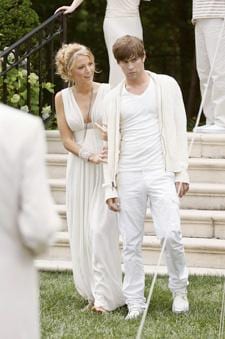A TV show like Gossip Girl has a remarkable line of predecessors, from 90210 to the OC. Pop culture continues its love affair with affluent beautiful teenagers and their titillating soon-to-be-an-adult struggles.
Gossip Girl presents us with the richesse and paltry dramas of New York’s Upper East Side. Using the Brandon-and-Brenda-Walsh formula two “poor” characters, a brother and sister (who are continually ridiculed for living in a gorgeous Brooklyn loft) are introduced into rich(er) society and through a series of expensive brunches and balls the usual drama ensues.
The show is very well written and delivers rapid-fire dialogue replete with obscure references and intelligent allusions. Here’s how one character describes Brown, the tony Ivey League university: “An enclave of trustafarians and children of celebrities who major in drum circles and semiotics. Whatever that is. I can’t wait for you to come home next Thanksgiving a militant veganista. Anemic and proud!”
It is in this tone that each episode delivers a constant stream of messages justifying frivolity and privilege with intelligent yet glib self-aware cynicism set to indie music like MGMT. A notable contributor is Jessica Queller who is well known in the dramedy industry for working on shows like the intensely loquacious Gilmore Girls.
I think Gossip Girl is hitting the perfect pitch right now. It has created the most intoxicating capitalist grand narrative since Sex and the City. In other words Gossip Girl really glorifies materialism and excess. Admittedly it is my latest and greatest guilty pleasure.
Gossip Girl rounds out its appeal with a tokenized gay played by Connor Paolo who was quoted in People Magazine saying about his character, “Eric is 14 so his decision to be gay could be permanent. It might not be. It’s about finding yourself. At the moment, this is who he sees himself as. That’s very empowering.” Yikes.
Fifteen-year-old actress Taylor Momsen plays Little J, a budding fashion designer who drops out of Grade 9 to pursue her career and falls in with the “wrong crowd,” partying in dive bars with models and photographers and ending up in the pages of a fictionalized Nylon-esque magazine.
In real life Momsen has made headlines by being photographed at the right parties with Debbie Harry, guitar legend Les Paul, scenester fashion queers and appearing on the cover of the most recent Page 6. Does life imitate art or vice versa? My head is spinning.
Taylor Momsen hanging out at a party with Les Paul strangely parallels someone like Lily Allen dating high-profile art dealer and gallerist Jay Jopling. It’s true, the man who famously nurtured a menagerie of artists from Damien Hirst to Jeff Wall is popping up on every gay pop gossip blog because he’s dating Allen.
This union is just the latest example of how the worlds of art and pop can blur together and illustrates the growing postmodern trend in North America for all sorts of media to freely mix.
Take Miley Cyrus for example. She is a Disney star who sings country tween pop music. She was just photographed wearing an Iron Maiden T-shirt and moccasin-style booties. I don’t know who would be more offended by her outfit, die-hard Iron Maiden fans or First Nations people. Me, I tend to be ambivalent since I am neither. Still, it raises important questions about the globalization of culture. For some it represents a great loss of meaningfulness — does anything mean anything anymore? For others, like Miley and myself, maybe we never had anything really meaningful to lose in the first place.
In the words of Gossip Girls narrator Kristen Bell: “You know you love me.”

 Why you can trust Xtra
Why you can trust Xtra


